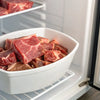Can You Mix Raw Meat and Dry Dog Food? Exploring the Benefits and Risks
- Houndsy
Table of Contents
- Introduction
- The Basics: Understanding Your Dog's Digestive System
- The Reasons Behind Mixed Feeding
- Potential Risks of Mixing Raw Meat and Kibble
- Safely Mixing Raw Meat and Dry Dog Food
- Rearranging Your Meal Times: Strategies for Success
- The Houndsy Commitment: Elevating the Feeding Experience
- Conclusion
- FAQ Section
Introduction
As pet parents, we’re continually seeking the best for our four-legged companions, particularly regarding their nutrition. A compelling statistic reveals that approximately 70% of dog owners are experimenting with alternative diets beyond just standard kibble. Many have raised the question, can you mix raw meat and dry dog food? This topic has sparked heated debates among dog lovers, veterinarians, and pet nutritionists alike.
Understanding how to effectively and safely nourish our dogs is crucial. The practice of combining raw meat with kibble can seem practical and beneficial, particularly for transitioning diets or budget constraints. Yet, many remain unsure about the implications of such combinations on their dog's overall health and digestion. In this blog post, we will unravel the complexities surrounding the mixed feeding of dogs, explore whether it's a safe practice, and present expert insights and practical strategies to navigate this dietary choice.
By the end, we hope to leave you with a clearer understanding of how to balance raw and dry food in your dog's diet responsibly. So, as you read on, we invite you to reflect on your own dog feeding routine: Have you ever considered mixing raw with kibble? What hesitations do you hold? Let’s delve into the science and recommendations on this fascinating topic.
The Basics: Understanding Your Dog's Digestive System
To address the question of mixing raw meat and dry dog food effectively, it’s necessary to first comprehend how a dog's digestive system works. Dogs are omnivores with a digestive anatomy that allows them to handle diverse food types; however, understanding the nuances of food digestion is essential.
1. Digestive Anatomy
The canine digestive system is designed to process a variety of food types. Digestion starts when your dog chews its food, mixing it with saliva, then continues into the stomach, where gastric juices break food down further. The stomach's acidic environment—typically between a pH of 1.5 and 2—plays a critical role in digesting proteins and reducing harmful bacteria.
Key Points:
- The stomach’s acidity protects against pathogens common in raw meat.
- Digestive enzymes in the stomach contribute to protein breakdown.
- An optimized pH level is crucial for effective digestion.
2. Digestion Rates of Kibble vs. Raw
One common myth is that kibble digests more slowly than raw meat. In reality, kibble can often be broken down more quickly due to its lower moisture content. Raw food, especially cuts that include bones, may take longer due to their fibrous composition.
3. Variations Based on Food Type
Different food types—including raw meat and kibble—can produce varying digestive results:
- Kibble is carbohydrate-rich, which can slightly raise the stomach's pH post-consumption.
- Raw meat, on the contrary, maintains stomach acidity and is high in protein.
4. The Impact of Mixed Feeding
When feeding raw meat mixed with kibble, the potential for raising the gastrointestinal pH exists. Increased pH levels can influence the body's ability to digest proteins efficiently and may lead to pathogenic bacteria surviving digestion. Our aim is to combine raw and kibble safely, understanding the risks involved while enhancing nutritional intake.
The Reasons Behind Mixed Feeding
1. Transitioning to Raw Diets
One of the significant reasons to mix raw meat with kibble is to assist dogs transitioning to a fully raw diet. A gradual introduction reduces the chances of gastrointestinal upset, which often occurs with an abrupt diet change.
2. Budget Considerations
Feeding an entirely raw diet can be cost-prohibitive for many pet owners. Mixing kibble with raw food may provide a solution that allows pets to experience the benefits of fresh food while maintaining budgetary restraints.
3. Convenience and Practicality
For pet owners with busy lifestyles or limitations regarding storage space, mixed feeding might be a convenient solution. Raw food often requires more preparation, while kibble can be served without much fuss.
4. Nutritional Enhancement
Adding raw food to kibble enhances nutrient intake. Fresh meat is packed with essential vitamins, minerals, and proteins that can elevate your dog's overall health.
Potential Risks of Mixing Raw Meat and Kibble
Despite the benefits, there are risks associated with combining raw meat and kibble that pet owners must be aware of:
1. Digestive Issues
For some dogs, mixing these two types of diets can lead to digestive upset. Symptoms can range from mild to severe, including vomiting and diarrhea. It’s essential to introduce any new food gradually and monitor your dog's reaction.
2. pH Imbalances
Mixing raw and kibble can raise the stomach's pH. If the pH becomes too high, it may impede the digestion of protein due to insufficiently acidic conditions, increasing the risk of bacterial survival.
3. Nutritional Imbalance
While raw foods can provide vital nutrients, over-relying on kibble could lead to an uneven nutritional profile. It's crucial to ensure that both the raw and dry components meet your pet’s nutritional needs.
Safely Mixing Raw Meat and Dry Dog Food
To mitigate risks while enjoying the advantages of a mixed diet, we can take several prudent steps.
1. Gradual Introduction
When introducing mixed feeding, do so slowly over several days or weeks. Start by adding a small amount of raw meat to the kibble and gradually increasing it according to your dog’s tolerance.
2. Monitor pH Levels
Consider using canine digestive aids, such as probiotics or apple cider vinegar, known for their ability to stabilize gut pH and boost digestion. Probiotics enhance digestion and combat harmful bacteria, while apple cider vinegar can lower pH levels effectively.
3. High-Quality Ingredients
Choose high-quality kibble infused with proteins and minimal fillers. Avoid products with high carbohydrate content, which exacerbates pH issues. Additionally, ensure that the raw meat is fresh and sourced from reputable providers.
4. Serving Size: Striking a Balance
If you opt for a half-and-half approach or any variation, consider your dog’s lifestyle, energy, and nutritional requirements. Often, a balance might lean towards 75% raw and 25% kibble, or vice versa, depending on individual factors.
5. Consultation with Veterinarians
Engage your veterinarian to devise a tailored plan for mixed feeding according to your dog's unique needs, whether it's size, age, or health conditions.
Rearranging Your Meal Times: Strategies for Success
Feeding routines can significantly affect how your dog digests its food. Here are a couple of strategies to implement mixed feeding successfully:
1. Separate Feeding Times
Consider feeding kibble in the morning and raw meat in the evening or vice versa. This practice allows each diet type to be digested optimally without immediately impacting each other in the gut.
2. Use of Meal Toppers
Rather than mixing the two types in a single bowl, consider using raw food as a topper on kibble, so your dog can enjoy the best of both worlds. This method allows for portion control and reduces risks associated with mixed feeding.
The Houndsy Commitment: Elevating the Feeding Experience
At Houndsy, we understand the importance of making feeding a seamless and enriching experience for both you and your canine companions. Our range of products—including the innovative Houndsy Kibble Dispenser—enhances meal prep and delivery with sleek, ergonomic design. Our dispenser maintains portion control and keeps kibble fresh, making it easier to manage mixed feeding routines effectively.
Explore how the Houndsy Kibble Dispenser can transform your feeding ritual and make every mealtime a joy. Order now!
Conclusion
Navigating the mixed feeding of raw meat and dry dog food presents an opportunity to enhance your dog’s nutrition while balancing their well-being. We’ve uncovered the science behind canine digestion, discussed practical advice for safe mixed feeding, and outlined the potential benefits and risks involved. Remember, as with any dietary practices, the key is to stay informed and attentive to your dog’s unique needs.
The journey of mixed feeding can be rewarding, providing both budget-friendly and nutritious meals for your beloved pet. We encourage you to embrace this practice if it suits your lifestyle, and to discover the perfect balance that works for both you and your furry friend. Have more questions about developing a mixed feeding routine? Feel free to explore our blog for additional insights and share your experiences with us!
FAQ Section
Can mixing raw meat with kibble cause digestive problems?
While many dogs adapt well to mixed feeding, some may experience digestive upset if introduced too quickly. It’s best to transition gradually and monitor how your pet responds.
What is the best ratio for mixing raw and kibble?
There’s no one-size-fits-all answer; however, a common recommendation is to start with 50% raw and 50% kibble and adjust according to your dog's needs and dietary response.
How can I safely introduce raw meat to my dog's diet?
Begin by mixing a small amount of raw meat with their current kibble and slowly increase the proportion. Consider using digestive aids like probiotics or apple cider vinegar to help with pH stability.
Should I consult my veterinarian before starting mixed feeding?
Yes, consulting your veterinarian is crucial for personalized nutrition based on your dog's health history, age, and activity level.
What should I look for in kibble to use for mixed feeding?
Opt for high-quality kibble with minimal fillers, sufficient protein content, and no artificial preservatives. This ensures your dog receives a balanced diet in both forms of food.
By ensuring that your pet’s nutritional needs are met while incorporating both raw and kibble into their diet, you’re contributing to their overall health and happiness. So why not explore how Houndsy can simplify your feeding routine today? Order Houndsy Kibble Dispenser now!













